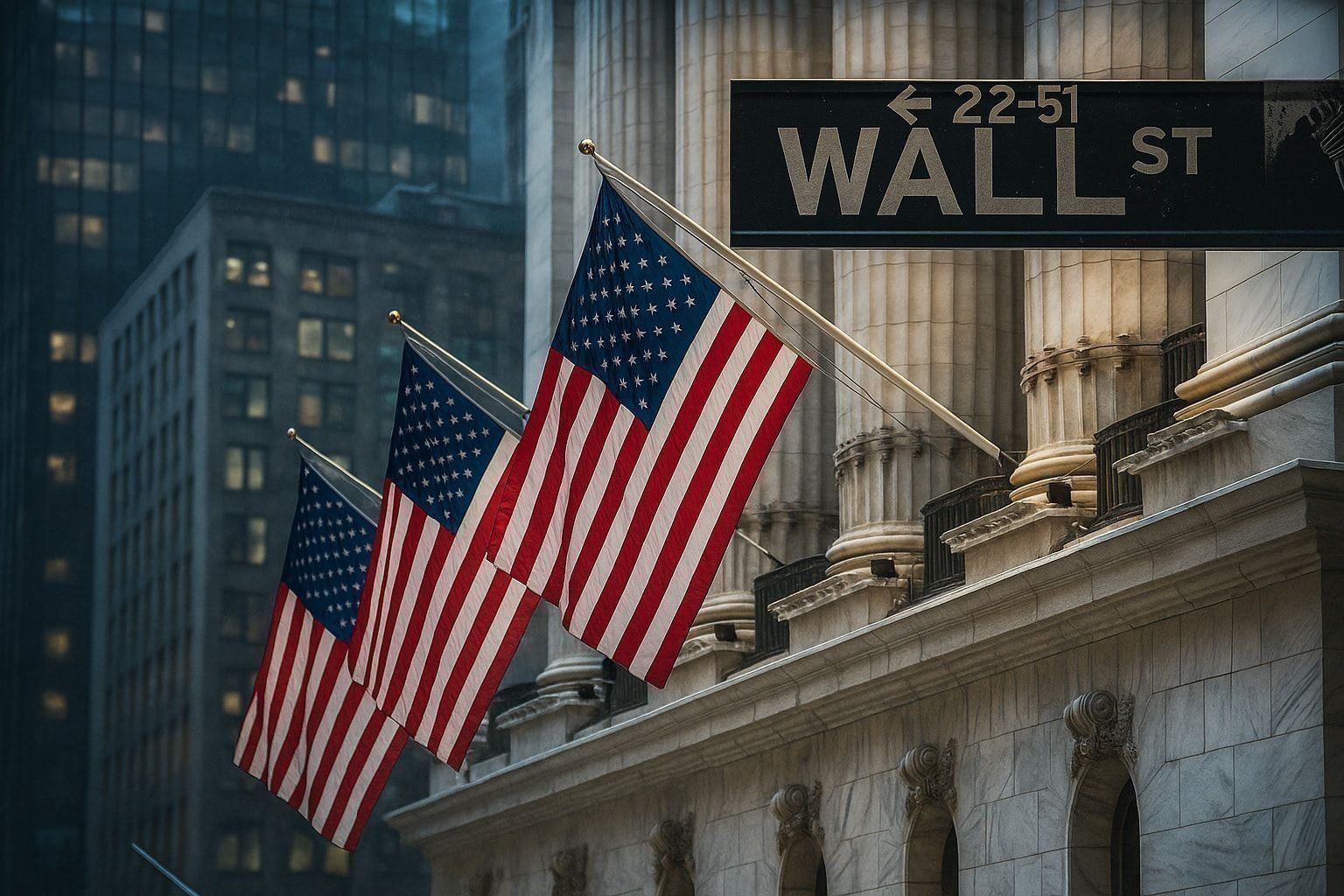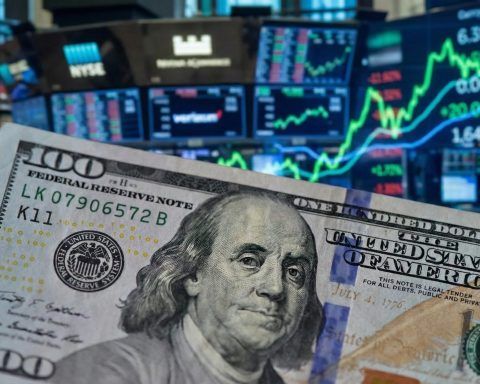New York — November 25, 2025 (after the bell)
U.S. stocks powered higher on Tuesday as a wave of softer economic data and dovish Federal Reserve expectations sent Treasury yields below 4% and reignited the “rate-cut rally” on Wall Street. Alphabet and Meta climbed on fresh AI news, while Nvidia lagged, and a handful of retailers staged eye‑popping moves.
Key Takeaways
- Dow Jones Industrial Average jumped 664.18 points (1.43%) to 47,112.45.
- S&P 500 gained 0.91% to 6,765.89, and the Nasdaq Composite added 0.67% to 23,025.59, marking the third straight advance for both the S&P and Nasdaq. [1]
- Small caps outperformed, with the Russell 2000 up about 2.1% to 2,465.98. [2]
- September retail sales rose just 0.2%, core sales dipped, and producer prices rose 0.3% — all part of a batch of data delayed by the recent 43‑day U.S. government shutdown. [3]
- Consumer confidence tumbled to 88.7 in November, the lowest since April, and job-market data pointed to a cooling labor backdrop. [4]
- Futures markets now price roughly an 85% chance of a December Fed rate cut, helping pull the 10‑year Treasury yield below 4% for the first time since late October. [5]
- Healthcare and retail led the S&P 500, while energy stocks fell alongside a drop in crude oil prices. [6]
Wall Street Extends Its Pre‑Thanksgiving Rally
All three major U.S. equity benchmarks closed in the green, extending the rebound that began late last week:
- Dow Jones Industrial Average: +664.18 points (+1.43%) to 47,112.45
- S&P 500: +60.77 points (+0.91%) to 6,765.89
- Nasdaq Composite: +153.59 points (+0.67%) to 23,025.59 [7]
The advance put the S&P 500 and Nasdaq on a three‑day winning streak as investors leaned further into the idea that the Fed is done hiking and is likely to deliver its third and final rate cut of 2025 at the December meeting. [8]
Smaller companies had an even better day. The Russell 2000 small‑cap index jumped about 2.1% to 2,465.98, underscoring a broadening of the rally after months in which mega‑cap tech dominated returns. [9]
Trading volume was slightly below its 20‑day average as the market headed into the holiday‑shortened Thanksgiving week, with U.S. exchanges set to close Thursday and operate on an abbreviated schedule Friday. [10]
Soft Data, Strong Cut Bets: What Moved Markets
Retail Sales, Inflation and Confidence
A cluster of U.S. economic reports, many delayed by the prolonged federal government shutdown, landed before the opening bell and set the tone for the session:
- Retail sales: Up 0.2% in September, half the 0.4% gain economists expected, after a 0.6% increase in August. “Core” retail sales — excluding autos, gasoline, building materials and food services — fell 0.1%, signaling more cautious consumer spending. [11]
- Producer Price Index (PPI): Headline producer prices rebounded 0.3% in September after a 0.1% decline in August, driven largely by a jump in energy costs and modest increases in underlying goods prices. [12]
- Consumer confidence: The Conference Board’s index dropped to 88.7 in November from 95.5 in October, missing forecasts near 93 and marking the weakest reading since April. Households reported greater concern about the labor market and fewer plans to buy big‑ticket items. [13]
On top of that, a separate private‑sector report from ADP estimated that U.S. private employers shed an average of 13,500 jobs over the four weeks ended Nov. 8, reinforcing the picture of a gradually softening labor market. [14]
Pending Home Sales Surprise to the Upside
Housing offered a rare bright spot. Pending home sales rose 1.9% in October from the prior month, beating expectations for a small 0.5% increase and following an upwardly revised 0.1% gain in September. [15]
The National Association of Realtors’ Pending Home Sales Index climbed to 76.3 from 74.8, though signings were still 0.4% below year‑earlier levels, highlighting how far the housing market remains from pre‑tightening norms despite a recent dip in mortgage rates. [16]
Yields Break Below 4% and Fed Cut Odds Jump
Bond traders seized on the softer tone of the data:
- The 10‑year Treasury yield fell about 3.8 basis points to 3.998%, slipping below the psychologically important 4% mark for the first time since October 29. [17]
- Fed funds futures now imply an ~84–85% probability of a 25‑basis‑point rate cut in December, up sharply from around 50% a week ago. [18]
Recent remarks from Fed officials — including New York Fed President John Williams and Governor Christopher Waller — have reinforced the perception that policymakers are increasingly concerned about labor‑market softness and willing to ease again despite still‑elevated inflation. [19]
For equity investors, lower yields translate into cheaper discount rates for future earnings, which tends to support growth and tech stocks and can justify higher valuations — at least in the short term.
Sector Moves: Healthcare and Retail Lead, Energy Lags
Healthcare Tops the S&P 500
Among the S&P 500’s 11 sectors, healthcare was the top performer on Tuesday, benefiting from falling bond yields and renewed appetite for defensive growth names. [20]
While individual movers varied, the sector generally benefits when investors expect:
- Lower discount rates (which boost the present value of steady long‑term cash flows), and
- A slower economy, which often makes non‑cyclical earnings streams relatively more attractive.
Retailers Ride Earnings Tailwinds
Despite the downbeat macro data on consumer sentiment and sales, retail stocks had a banner day thanks to company‑specific earnings surprises:
- Kohl’s (KSS) surged 42.5% after the department‑store chain raised its full‑year earnings forecast, signaling resilience among its shoppers.
- Abercrombie & Fitch (ANF) rocketed 37.5% on its own upbeat outlook.
- The S&P 500 Retail Index climbed about 2%, making it one of the day’s strongest industry groups. [21]
Not all retailers joined the celebration. Burlington Stores (BURL) dropped 12.2% after missing third‑quarter revenue expectations, showing that weaker consumer confidence is still squeezing some chains. [22]
Energy Stocks Dragged Down by Lower Crude
At the other end of the spectrum, energy shares suffered the steepest percentage decline of any S&P 500 sector. [23]
Oil prices slid as traders digested both the softer U.S. data and headlines suggesting progress toward a U.S.-backed framework to end the war in Ukraine:
- U.S. crude fell roughly 1.6% to about $57.89 a barrel. [24]
- Brent crude also moved lower, pressuring producers and integrated majors.
Lower energy prices provide some relief on the inflation front but weigh directly on energy earnings expectations, explaining the sector’s underperformance on a day when most stocks were higher.
Mega‑Cap Tech: Alphabet and Meta Climb, Nvidia Slips
The AI trade continued to dominate the narrative around mega‑cap tech, but leadership within the group is shifting.
Alphabet Nears a $4 Trillion Milestone
Alphabet (GOOGL) rose about 1.5% and briefly touched a fresh intraday record near $329 per share after a report in The Information said Meta Platforms is in talks to use Google’s AI chips in its data centers starting in 2027 and to rent capacity from Google Cloud as soon as next year. [25]
The move keeps Alphabet on track toward a $4 trillion market capitalization, driven by a year‑long rally fueled by its sharpened focus on AI tools and infrastructure. [26]
Meta (META) jumped 3.8%, making it the single biggest positive contributor to the S&P 500 on the day. [27]
Nvidia’s Slump Caps Nasdaq Gains
In contrast, Nvidia (NVDA) — one of the flagship winners of the AI boom — fell 2.6%, limiting the Nasdaq’s advance. [28]
Despite Nvidia’s slide, the Philadelphia Semiconductor Index eked out a 0.2% gain, a sign that investors are not abandoning the AI hardware theme but are becoming more selective on valuation and competitive dynamics as buyers like Meta diversify their chip suppliers. [29]
Tech Valuations Under the Microscope
A separate Reuters analysis underscored how stretched U.S. tech valuations have become:
- Tech companies now make up about 31.1% of the S&P 500’s total market capitalization but only around 20.8% of its earnings, a widening gap compared with earlier this year. [30]
- The Nasdaq Composite trades at a forward P/E of roughly 29, well above its 10‑year average near 23.5 and significantly higher than the S&P 500’s overall multiple. [31]
Analysts warn that such a disconnect between price and profit leaves the sector vulnerable to disappointments — especially if the AI spending boom slows.
AI Infrastructure, Jobs and the PC Cycle: Dell and HP in Focus
Beyond the mega‑caps, several notable corporate stories in the AI and hardware space hit the tape Tuesday.
Dell Raises Its AI Server Targets
Dell Technologies (DELL) issued upbeat guidance after the bell, forecasting:
- Fourth‑quarter revenue of $31–32 billion, comfortably above Wall Street estimates, and
- Adjusted profit of $3.50 per share, topping consensus expectations. [32]
The company now expects $25 billion in fiscal 2026 revenue from AI server shipments, up from a prior $20 billion forecast, citing strong demand from data‑center clients including the U.S. Department of Energy, Abu Dhabi’s G42, Elon Musk’s xAI and CoreWeave. [33]
Dell’s results and targets helped reassure investors that AI infrastructure demand remains robust, even as questions swirl around chip‑maker valuations.
HP Announces Job Cuts and AI‑Driven Restructuring
HP Inc. (HPQ) announced plans to cut between 4,000 and 6,000 jobs globally by fiscal 2028, part of a restructuring aimed at streamlining operations and accelerating the adoption of AI across product development, internal processes and customer support. [34]
Management expects the initiative to generate about $1 billion in annual gross run‑rate savings over three years. AI‑enabled PCs already account for more than 30% of HP’s shipments, but rising memory‑chip costs — themselves a byproduct of AI data‑center demand — could pressure margins, prompting HP to qualify cheaper suppliers and tweak product configurations. [35]
Amazon’s $50 Billion AI Pledge Still Resonates
Investors also continued to digest Amazon’s announcement Monday that it will invest up to $50 billion to expand AI and supercomputing capacity for U.S. government customers through its AWS cloud unit — one of the largest public‑sector cloud infrastructure commitments on record. [36]
The initiative underscores how AI infrastructure has become a strategic arms race, not just among tech giants, but between the U.S. and geopolitical rivals.
Housing and the Consumer: Can the Fed Thread the Needle?
Tuesday’s data painted a nuanced picture of the U.S. economy:
- Retail sales and core spending showed signs of fatigue, especially among lower‑ and middle‑income households facing higher prices and a softer job market. [37]
- Consumer confidence recorded its largest drop since April, with fewer Americans saying jobs are “plentiful” and more expecting income and business conditions to worsen over the next six months. [38]
- Pending home sales surprised to the upside, thanks to slightly lower mortgage rates and improved affordability in some regions — particularly the Midwest and parts of the Northeast and South — even as overall signings remain below last year’s levels. [39]
For the Fed, this mix is tricky:
- Inflation progress is gradual, not linear, with producer prices still supported by energy. [40]
- The labor market is losing momentum, as evidenced by rising unemployment near 4.4% and weaker private‑sector hiring. [41]
That combination explains why markets now heavily favor a December rate cut but also why Fed officials have not unanimously embraced a dovish pivot.
What Today’s Move Means for Investors
For traders and longer‑term investors alike, Tuesday’s post‑bell picture carries several implications:
- The “rate‑cut trade” is back in the driver’s seat. Equities, especially rate‑sensitive growth and small‑caps, are responding strongly to lower yields and rising confidence in a December Fed cut. However, a single stronger‑than‑expected data print or a hawkish Fed comment could challenge that consensus.
- Leadership beneath the surface is shifting.
- Healthcare and select defensives benefited from the move in yields.
- Retail stocks showed that good execution can still trump weak macro headlines.
- Energy is once again behaving like a macro hedge: down when growth concerns and peace hopes pressure crude.
- AI winners are fragmenting.
Alphabet, Meta, Dell, HP and Amazon all underscored that AI is more than just Nvidia and a handful of mega‑caps. But with tech’s share of index market value far outpacing its share of earnings, valuation risk is building, especially if AI spending normalizes. [42] - Volatility around data remains likely.
Because many government reports were delayed by the shutdown and are now being released in a compressed window, markets may continue to react sharply to each new datapoint on growth, inflation and employment.
As always, investors should align any decisions with their time horizon, risk tolerance and diversification goals, recognizing that while lower rates and AI enthusiasm are powerful tailwinds, they also come with elevated expectations — and little margin for disappointment.
References
1. www.reuters.com, 2. www.seattlepi.com, 3. www.reuters.com, 4. www.conference-board.org, 5. www.reuters.com, 6. www.reuters.com, 7. www.reuters.com, 8. www.reuters.com, 9. www.seattlepi.com, 10. www.reuters.com, 11. www.reuters.com, 12. www.reuters.com, 13. www.conference-board.org, 14. www.reuters.com, 15. www.reuters.com, 16. www.reuters.com, 17. www.reuters.com, 18. www.reuters.com, 19. www.reuters.com, 20. www.reuters.com, 21. www.reuters.com, 22. www.reuters.com, 23. www.reuters.com, 24. www.reuters.com, 25. www.reuters.com, 26. www.reuters.com, 27. www.reuters.com, 28. www.reuters.com, 29. www.reuters.com, 30. www.reuters.com, 31. www.reuters.com, 32. www.reuters.com, 33. www.reuters.com, 34. www.reuters.com, 35. www.reuters.com, 36. www.reuters.com, 37. www.reuters.com, 38. www.conference-board.org, 39. www.reuters.com, 40. www.reuters.com, 41. www.reuters.com, 42. www.reuters.com










